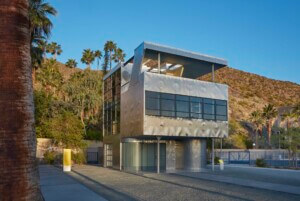How can innovative design achieve zero net energy?
This is the challenge put forth by Chester “Chet” Widom, FAIA, State Architect of California, in the “7x7x7: Design, Energy, Water” initiative for the state’s education system. California has the largest population of any state in the union, yet it is strapped by a 5-year long drought that threatens the state’s economy and way of life.
In light of these concerns, Widom examined the geography and geology of California and determined the state is made up of seven distinct ecologies. He selected seven of the state’s leading sustainable design firms (WRNS Studio, Aedis Architects, Lionakis, Ehrlich Architects, DLR Group, Hamilton + Aitken Architects, and HGA Architects) and gave each an educational institution to study. Faced with unique instances of geographic and demographic diversity, the seven architecture firms were each asked to develop a conceptual case study that could form the foundation for a major state-wide campus design revolution.
In February, the California Division of the State Architect (DSA) completed a new initiative called “7x7x7: Design, Energy, Water,” that highlights ways to “improve the built environment while simultaneously greening California’s aging school facilities.” Widom pointed out that California has 10,000 campuses serving students from Kindergarten through community college. He postulated that each campus has an average of five buildings in need of renovation, meaning 50,000 buildings must be adapted, state-wide; a staggering challenge, indeed. But, if the state could use energy and water reductions to save $3,000 per year per structure over ten years, it could save $1.5 billion overall, money that could be put back into young people’s education.
That ambition inspires the seven imaginative projects dispersed across the state.
WRNS Studio and Ehrlich Architects were challenged by the harsh, tight urban environments of their sites in Oakland and South-Central Los Angeles, respectively. Both elected to use the energy and water challenge to totally transform their campuses. At Lincoln Elementary School in Oakland, dubbed “a place of asphalt” by Pauline Souza of WRNS, the team connected the students to nature by developing what Le Corbusier called the “5th facade,” the roof, into outdoor, PV-powered energy-efficient classrooms. Souza said they would achieve 45% energy and water reductions by creating more natural environments for their “harshest critics,” 6-11 year-olds. Ehrlich Architects, with Mia Lehrer + Associates landscape architects, transformed the entire site—ground plane and roof—into a learning garden. Through xeriscape landscape interventions they would divert 200,000 gallons of water annually to be used for irrigation, education, and to teach students the value of the local watershed. This would ultimately turn, said the architects, “the entire campus into a learning tool.”
Embracing advanced technology in diverse climates led DLR and HGA to bring us back to the future. Working at the Bubbling Wells Elementary School in hot and windy Desert Hot Springs, DLR explored ideas to conserve energy and water, like “Water Harvesting.” This concept uses the wind to run a series of compressors that collect condensate from the humidity in the air, essentially capturing water out of thin air. DLR is now exploring a test of this technology with the Palm Springs Unified School District. In downtown LA, HGA was asked to study Los Angeles Trade Technical College. Rather than seeking to achieve Zero Net Energy, the firm instead suggested changing the question: What would happen if the project “started at zero” and moved toward the positive? With an integrated approach using cloud-based computer analysis and parametric modeling, HGA analyzed 640,000 combinations of design strategies to improve the healthiness and energy-efficiency of the school. One impressive result was the reduction in carbon emissions. The current building currently produces 2 million pounds of carbon dioxide per year, the equivalent of the CO2 produced by 191 cars annually, but with a cluster of design interventions, the team would reduce carbon emissions to zero.
“DSA is proactive in meeting Governor Brown’s directive to achieve Zero Net Energy by 2030” and that, “7x7x7: Design, Energy, Water, is just the beginning of a process that has the power to transform 10,000 campuses and help teach millions of California students how to become stewards of their own environment,” Widom explained.










